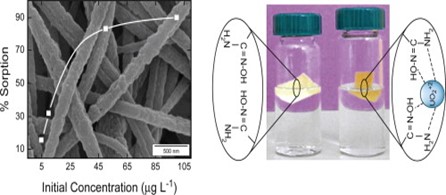Research Topics
Fibrous Membranes for Efficient Heavy Metal Removal
Population growth and industrialization activities are leading to serious environmental pollution problems and many people worldwide are suffering from the lack of water and poor air quality. Modern environmental remediation strategies involve the implementation of a new generation of filter membranes and technologies, such as nanofibers fabricated by electrospinning. Electrospun nanofibers are new filtering media applied for effective filtrations by virtue of their intrinsic porosity, large surface area, and high chemical and thermal stability. The functionality and selectivity can be further improved by appropriate surface modifications. Nano-sized chitosan fibers were utilized for sorption of Fe(III), Cu(II), Ag(I), and Cd(II) ions from aqueous solutions. The surface of chitosan fibers was further functionalized by monodisperse nano zero-valent iron (nZVI) particles for the removal of inorganic arsenic species.

Sorption of radioactive U(VI) ions from aqueous systems via column sorption under continuous flow was performed using amidoximated polyacrylonitrile fibers.
The electrospinning technique is versatile and allows the spinning of the polymer in the presence of active material as well as the post-treatment processes applied to the polymeric film obtained. Zeolite, a natural adsorbent, was added to polyacrylonitrile and turned into the fiber, and used to remove the organic dye. Furthermore, water quality monitoring was combined with the artificial intelligence-based mobile application.

Hierarchically Structured Metal Oxide Fibers: Promising Carrier Material for Catalytical Applications
Hybrid electrospun nanofibers are a class of materials mostly based on organic polymers and inorganic substances. The combination of electrospun nanofibers and inorganic nanomaterials in one object yields hybrid materials that are intrinsically porous and possess higher chemical and thermal stability. There are different strategies to produce hybrid electrospun fibers in electrospinning of precursors, electrospinning of ex-situ synthesized inorganic materials, surface crystallization on electrospun fibers, and a combination of these methods.
The simultaneous electrospinning of ceria and lithium cobalt oxide precursors and silica nanoparticles allows the fabrication of hierarchically structured composite nanofibers. The metal oxide was found to nucleate predominantly at the surface of the fibers during the calcination process, forming nanoparticles that were mainly present among larger silica nanoparticles on the surface of even larger fibers. This hierarchical structural organization enhanced the available surface area of the catalytically active metal oxide component and improved accordingly the efficiency of the system for catalysis, as shown by the successful degradation of a fluorescent dye by ceria fibers.
 A simple heat treatment modification has been proposed to increase the photocatalytic degradation performance of metal oxides in addition to their adsorption capabilities. This approach will be of great benefit in its application as photocatalysis and adsorption in the treatment of wastewater containing heavy metals and organic pollutants in various textile, printing, and chemical industries.
A simple heat treatment modification has been proposed to increase the photocatalytic degradation performance of metal oxides in addition to their adsorption capabilities. This approach will be of great benefit in its application as photocatalysis and adsorption in the treatment of wastewater containing heavy metals and organic pollutants in various textile, printing, and chemical industries.
 In addition to metal oxide-based nanofibers, it is also possible to obtain nanofibers modified with metal nanoparticles. Fibrous polystyrene membranes are prepared by electrospinning and they are subjected to post-modification with gold nanoparticles. The composite membranes may provide a convenient environment for the removal of bovine serum albumin (BSA) from BSA and deoxyribonucleic acid (DNA) mixtures. The eluent can be used as an efficient tool for detection of DNA biomarkers associated with diagnosis of numerous life-threatening diseases.
In addition to metal oxide-based nanofibers, it is also possible to obtain nanofibers modified with metal nanoparticles. Fibrous polystyrene membranes are prepared by electrospinning and they are subjected to post-modification with gold nanoparticles. The composite membranes may provide a convenient environment for the removal of bovine serum albumin (BSA) from BSA and deoxyribonucleic acid (DNA) mixtures. The eluent can be used as an efficient tool for detection of DNA biomarkers associated with diagnosis of numerous life-threatening diseases.

Electrospun Nanomaterials as Ultrasensitive Sensors
Volatile organic compounds (VOCs) are major contributors to indoor air pollution. Involuntary inhalation of VOCs leads to numerous diseases in children and elderly people particularly for those having asthma, allergies, or other respiratory illness, and causes special risks. Because of the importance of indoor air quality for the health and welfare of people, the utilization of highly efficient sensors for the detection and monitoring of VOCs became a crucial attempt.
We highlighted sensing applications associated with the remarkable features of the electrospun metal oxide nanofibrous mat. The preparation method of QCM coating is versatile and can also be used to fabricate several active nanofibrous materials. The electrospun fibers coated QCM sensors offer easy handling, high sensitivity, as well as good reproducibility. We envisaged that this strategy enables the efficient design and development of other QCM coatings toward toxic gases and vapors.

Nanoelectrodes for Lithium-ion Batteries
Electrospun LiCoO2 and colloidal titania nanoparticles (TiO2 NPs)-doped LiCoO2 nanofibers as cathode electrodes in lithium-ion batteries have been fabricated. The increment in the calcination temperature and Li:Co mole ratio provides a lower capacity loss and higher performance of the battery. Furthermore, while the crystallinity and stability of the LiCoO2 phase are improved, the presence of the TiO2 NPs causes a transformation of binary LiCoO2 to ternary Li-based transition metal oxide, Li2CoTi3O8. The synthesis parameters affect the structural characteristics of the LiCoO2 and Li2CoTi3O8/TiO2 nanostructures and consequently, the change in their size, porosity, surface area, and geometry have a strong impact on battery performance. Therefore, new electrode materials, particularly Li-rich layered oxide nanomaterials, for high energy density and long cycle life batteries need to be developed for the requirement of intensive power sources through the continually growing energy markets.


